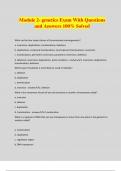College aantekeningen
Course notes Media Systems in Comparative Perspective (CM1008)
- Instelling
- Erasmus Universiteit Rotterdam (EUR)
Media Systems in Comparative Perspectives, Erasmus University Rotterdam. This documents shows the importance and relevance of comparing media systems with a political lens through a detailed summary of the course notes, mock exam questions, flashcards and a thorough analysis of the concepts discus...
[Meer zien]













